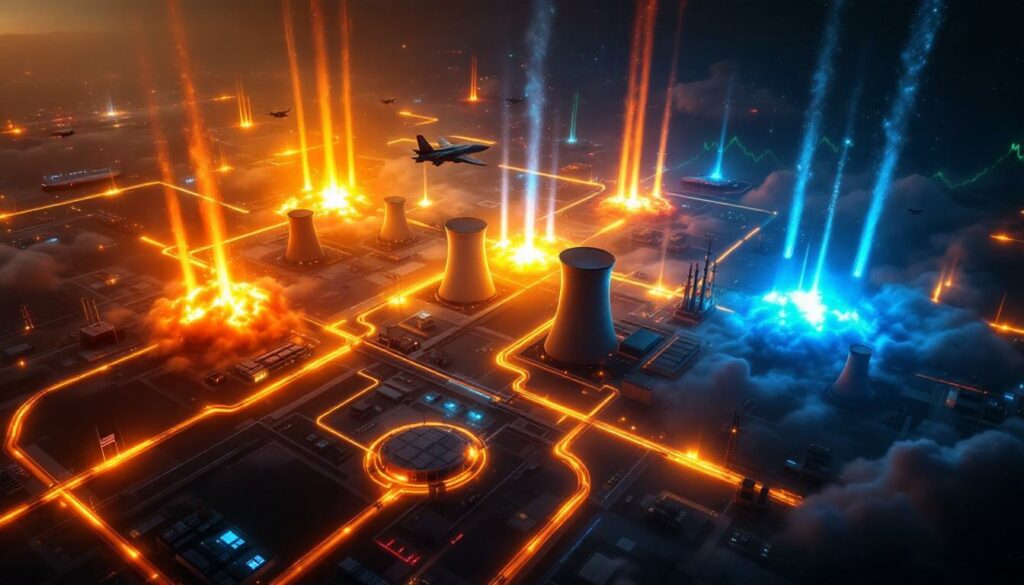What Happened During the US Strike on Iranian Nuclear Facilities?
The United States conducted a historic, targeted military strike against Iranian nuclear facilities in June 2025, marking a significant escalation in Middle East tensions. As Diego Parrilla, CIO of Quadriga Asset Managers, noted, "It's historic in the sense that to have the US directly intervening in the Middle East again, especially in Iran, is major." This precision operation specifically focused on Iran's nuclear infrastructure—facilities whose existence Iran had officially denied—demonstrating a clear strategic objective to weaken Iran's nuclear capabilities while minimizing broader conflict escalation.
"It shows the surgical approach of the attack, very focused on the nuclear side," Parrilla observed, highlighting how the operation revealed key strategic priorities: signaling serious concerns about Iran's nuclear program development and demonstrating US willingness to take decisive military action when diplomatic channels fail to address nuclear proliferation concerns.
International Response to the Action
The international response proved notably measured. Russia expressed "deep regret" over the US action but used surprisingly mild language compared to what might have been expected from a traditional Iranian ally. China emphasized concerns about disruption to important international trade routes but stopped short of strong condemnation, with their foreign minister stating: "The Gulf and surrounding waters are important international trade routes."
This muted response from major powers suggests a complex geopolitical calculation where even Iran's partners recognize the problematic nature of its nuclear ambitions, creating an environment where Iran faces limited diplomatic support for significant escalation. The US–China trade tensions further complicate the international diplomatic landscape.
How Did Financial Markets React to the Strike?
Despite the historic nature of direct US military action against Iran, financial markets showed remarkably restrained reactions. Oil prices rose only about 1.7% initially, with gold remaining essentially flat and silver up approximately 2%. Bond yields barely moved, and the US dollar index (DXY) showed only modest gains—a response that contradicted typical expectations for significant market volatility following major Middle East military actions.
"The market's not necessarily complacent," explained Parrilla, "but I think it's being somewhat realistic about the extent to which Iran can actually scale things up." This suggests sophisticated risk assessment by investors who, rather than panic selling, evaluated the surgical nature of the strikes, limited escalation potential, and Iran's constrained ability to retaliate meaningfully.
Oil Market Dynamics and Price Stability
The oil market's limited reaction reflected several key factors. First, markets had already priced in significant geopolitical risk premiums. Second, traders recognized that despite Iranian threats, the actual likelihood of closing the Strait of Hormuz remains low.
"There have been approximately 15 threats to close the strait since 1980, none of which materialized," noted Parrilla. Iran itself depends on oil exports through these waters, particularly to China, which receives 80-90% of its Iranian oil imports via this route. Any closure would effectively cut off Iran's economic lifeline to its most important ally.
Nevertheless, Goldman Sachs estimates suggest sustained disruptions could potentially drive oil prices to $90-100 per barrel in extreme scenarios—a risk factor that markets are monitoring but not panicking over. Recent oil price crash insights provide additional context for understanding the market's measured response.
What Are the Geopolitical Implications of This Conflict?
The strike has highlighted shifting regional alliances in the Middle East. Saudi Arabia's dramatically different perspective on Iran compared to previous decades reflects a broader realignment of Sunni-Shia dynamics. The Arab world appears less unified in opposition to Israel than in previous conflicts, with pragmatic considerations increasingly outweighing ideological positions.
"The entire Shia-Sunni conflict… the Arab world becoming a little bit less extreme," Parrilla observed, pointing to fragmentation of traditional alliances that limits Iran's ability to mobilize regional support for significant escalation.
Iran's Strategic Limitations and Vulnerabilities
Iran faces significant strategic constraints in mounting an effective response. According to Parrilla, "They've used half the stockpiles… Israel is extremely well prepared to fight back," suggesting Iran has already depleted approximately half of its missile stockpiles in previous attacks against Israel, with limited impact due to Israel's advanced defense systems.
Additionally, Iran confronts multiple challenges simultaneously: economic sanctions, internal political dissent, and the need to maintain oil exports to allies like China. These factors severely restrict Iran's options for meaningful retaliation without risking further isolation or economic damage.
Broader Global Security Implications
The US strike represents a significant moment in nuclear non-proliferation efforts. By demonstrating willingness to use military force against nuclear development programs, the US has established a precedent that may influence calculations by other nations with nuclear ambitions.
The international response—particularly Russia's muted reaction despite its traditional alignment with Iran—suggests global powers recognize the legitimacy of concerns about Iranian nuclear development, even if they disagree with the method of addressing it. The UN Security Council has convened emergency sessions to address the situation, highlighting the global significance of these developments.
What Does This Mean for Global Economic Stability?
The conflict adds another dimension to an already complex global economic picture. While immediate market reactions were muted, the potential for energy price volatility remains a concern for global economic stability.
"Goldman Sachs estimates could take the oil price to maybe 90 or even 100 plus in highly sustained scenarios," Parrilla noted, highlighting that even if a complete closure of the Strait of Hormuz remains unlikely, targeted disruptions could impact global supply chains already strained by other geopolitical tensions.
Dollar Dynamics and Treasury Market Concerns
The geopolitical tensions occur against a backdrop of changing dollar dynamics. "The dollar has shifted from being a consensus long to a consensus short," explained Parrilla, raising questions about the dollar's traditional role as a safe-haven currency during geopolitical crises.
Similarly, US Treasury markets face scrutiny regarding their reliability as portfolio defenders during periods of heightened global instability. With US interest coverage "already over one trillion a year and 50% of the budget deficit," according to Parrilla, the sustainability of this traditional safe haven is increasingly questioned by market participants.
The "Stackflation" Risk Scenario
The combination of structural inflation pressures, high government debt levels, and geopolitical tensions creates what some analysts call "stackflation" risk—persistent inflation despite economic slowdowns, driven by monetary policy constraints and supply chain disruptions.
"The threat of inflation and… the long end of the curve… can become reflexive and it's a huge issue," warned Parrilla. The Iranian conflict represents another potential contributor to this challenging economic environment, where traditional monetary policy tools may prove less effective than in previous cycles due to the unique combination of inflationary pressures. Recent US tariffs and inflation trends compound these concerns.
How Does This Conflict Intersect with Other Global Tensions?
The Iranian conflict unfolds against the backdrop of ongoing US-China trade tensions. With the US tariff pause scheduled to end on July 9th, 2025, markets face additional uncertainty about potential economic disruptions.
"The entire tariff roller coaster… Trump has proven to be a poker player… a zero-sum game kind of guy," Parrilla observed, suggesting that businesses face unpredictable policy shifts that complicate investment decisions and supply chain management.
US-China Relations and Global Trade
Recent talks between US and Chinese officials in London produced positive rhetoric but few concrete results, leaving businesses and investors uncertain about future trade conditions between the world's largest economies.
"China has been the adult in the room… more pragmatic," noted Parrilla, but this pragmatism hasn't translated into resolution of key trade issues. The production shifts resulting from trade tensions—such as Apple moving some operations to India—haven't satisfied the fundamental goal of reshoring manufacturing to the United States, creating ongoing friction in the relationship.
Global Inflation Concerns and Monetary Policy
The conflict adds another variable to already complex inflation dynamics. While immediate market reactions were muted, sustained energy price increases could complicate central bank efforts to manage inflation expectations.
This creates particular challenges for the Federal Reserve, which must balance inflation concerns against economic growth objectives while also considering how geopolitical tensions might impact financial conditions—an increasingly difficult balancing act in a fragmented global economy.
What Are the Potential Scenarios for Further Escalation?
The most likely scenario involves limited Iranian retaliation through proxy forces or targeted attacks on US allies in the region. Iran's Revolutionary Guard may activate militant groups in Iraq, Syria, or Lebanon to conduct operations that maintain face domestically while avoiding direct confrontation with superior US and Israeli military capabilities.
Cyber attacks represent another potential avenue for Iranian response that falls below the threshold for major military escalation, allowing Iran to demonstrate capabilities without triggering overwhelming military responses.
Oil Infrastructure Vulnerabilities
While a complete closure of the Strait of Hormuz remains unlikely due to the self-harm it would inflict on Iran's economy, targeted attacks on oil infrastructure in Saudi Arabia or other Gulf states remain possible. Previous drone strikes on Saudi oil facilities in 2019 demonstrated Iran's capabilities in this domain.
Such actions could temporarily disrupt production and create market volatility without triggering full-scale military responses from the US and its allies—a calculated approach that allows Iran to respond without risking existential conflict.
Internal Iranian Political Dynamics
The strikes may accelerate internal political tensions within Iran. The regime's inability to prevent attacks on nuclear facilities—facilities whose existence they officially denied—undermines domestic credibility.
This could strengthen opposition movements or create divisions within the power structure, potentially leading to unpredictable policy shifts as factions compete to demonstrate strength and resilience in the face of external pressure.
How Should Investors Position Their Portfolios?
Investors need to move beyond what Parrilla calls "false diversification"—the mistake of confusing having many assets with having truly diversified exposure. "For example, holding 20 different cryptocurrencies doesn't provide meaningful diversification when these assets typically move in parallel," he explained.
True diversification requires assets that respond differently under specific stress scenarios, particularly during periods of geopolitical tension. This means looking beyond traditional correlations to understand how assets perform specifically during crisis events. Recent gold prices analysis shows how precious metals can function as portfolio stabilizers during geopolitical crises.
The Team Approach to Portfolio Construction
Parrilla suggests thinking about portfolio construction like building a sports team: "Many investors focus exclusively on 'strikers' (growth assets) while neglecting 'defenders' (protective assets)."
The challenge is that traditional defensive assets like government bonds may not provide reliable protection during certain crisis scenarios. "This necessitates more sophisticated approaches to portfolio defense, potentially including options strategies and alternative assets that can perform when both stocks and bonds decline," he noted.
Rebalancing Alpha and Volatility Management
Rather than fearing volatility, sophisticated investors can embrace it through strategic rebalancing. This approach treats market volatility as an opportunity to systematically sell assets that have appreciated and purchase those that have declined.
This "rebalancing alpha" can add significant value over time, particularly during periods of heightened geopolitical tension when market swings create tactical opportunities. By maintaining discipline through market turbulence, investors can potentially enhance returns while reducing overall portfolio risk. Some investors are exploring uranium market volatility as another avenue for portfolio diversification.
What Lessons Can We Learn from This Geopolitical Crisis?
The US strike demonstrates how modern geopolitical conflicts increasingly involve precise, limited military actions rather than broad-scale invasions. This surgical approach reflects technological capabilities that allow for targeted strikes with minimal collateral damage, but also recognition of the economic and diplomatic costs of extended military engagements.
"Future conflicts may continue this pattern of limited but highly consequential military actions," suggested Parrilla, highlighting a fundamental shift in how major powers project force in the 21st century.
Market Adaptation to Geopolitical Risk
Financial markets have developed more sophisticated approaches to pricing geopolitical risk. Rather than knee-jerk reactions to headlines, markets increasingly differentiate between truly systemic threats and more contained conflicts.
This evolution reflects both better information processing and the experience gained from previous geopolitical crises that proved less economically disruptive than initially feared. The muted market response to the Iranian strikes exemplifies this more nuanced approach to geopolitical risk assessment.
The Persistence of Uncertainty
Perhaps the most important lesson is that uncertainty remains the defining feature of the current geopolitical and economic landscape. From military conflicts to trade tensions to monetary policy, decision-makers face an unusually complex set of variables with limited historical precedent.
This environment rewards flexibility, scenario planning, and risk management approaches that can adapt to rapidly changing conditions. Rather than betting on specific outcomes, successful investors and policymakers will likely focus on building resilience across multiple potential scenarios.
FAQs About the US Strike on Iranian Nuclear Facilities
How does this strike differ from previous US military actions in the Middle East?
This strike represents a direct US military action against Iranian sovereign territory, specifically targeting nuclear facilities. This differs from previous US operations that focused on terrorist groups, proxy forces, or military assets outside Iran's borders. The surgical nature of the strike also distinguishes it from broader military campaigns like those in Iraq or Afghanistan, reflecting a more targeted approach to addressing specific security threats.
Could this conflict disrupt global oil supplies?
While a complete disruption remains unlikely, targeted attacks on oil infrastructure could create temporary supply issues. The greatest risk involves potential attacks on Saudi or UAE oil facilities rather than a complete closure of the Strait of Hormuz. Goldman Sachs estimates suggest sustained disruptions could drive oil prices to $90-100 per barrel, though markets have already priced in some risk premium.
How might this conflict impact global inflation trends?
The immediate impact appears limited, but sustained energy price increases could complicate inflation management for central banks. This would be particularly challenging in Europe, which faces greater energy dependency than the United States. The potential for "stackflation"—persistent inflation despite economic slowdowns—represents a significant risk should the conflict escalate or combine with other economic pressures.
What indicators should investors watch to assess escalation risks?
Key indicators include: movements of US naval assets in the region, statements from Iranian Revolutionary Guard leadership (distinct from diplomatic channels), positioning by Russian and Chinese officials at the UN Security Council, and any unusual activity among Iranian proxy groups in Lebanon, Syria, or Yemen. Oil price volatility and options market pricing can also provide early signals of market concerns about escalation.
How might this conflict affect US-China relations?
The conflict adds another complex variable to already strained US-China relations. China receives 80-90% of its Iranian oil imports through the Strait of Hormuz, giving it a strong interest in regional stability. This shared interest in preventing major disruptions could potentially create limited cooperation opportunities despite broader strategic competition, particularly as both nations navigate the complexities of global energy security.
Ready to Spot the Next Major Mineral Discovery?
Discovery Alert's proprietary Discovery IQ model provides real-time alerts on significant ASX mineral discoveries, giving investors a crucial edge before market movements occur. Visit the Discovery Alert discoveries page to understand how historic mineral discoveries have generated substantial returns for early investors.




